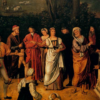Book Review: Jesus’ Crucifixion Beatings and the Book of Proverbs, by David Wenkel
David Wenkel, Jesus’ Crucifixion Beatings and the Book of Proverbs. Palgrave Macmillan, 2017. $40.00. 142 pps.
* * * * *
Editor’s note: If you’d like a free PDF chapter of this book, you can email the author at dwenkel@gmail.com.
Charles Spurgeon tells a story in his book The Soul-Winner that provides a good illustration for why pastors will be helped by David Wenkel’s Jesus’ Crucifixion Beatings and the Book of Proverbs. He writes,
Remember the story of the old minister who heard a sermon by a young man, and when he was asked by the preacher what he thought of it he was rather slow to answer, but at last he said,
“If I must tell you, I did not like it at all; there was no Christ in your sermon.”
“No,” answered the young man, “because I did not see that Christ was in the text.”
“Oh!” said the old minister, “but do you not know that from every little town and village and tiny hamlet in England there is a road leading to London? Whenever I get hold of a text, I say to myself, ‘There is a road from here to Jesus Christ, and I mean to keep on His track till I get to Him.’”[1]
Wenkel’s book is an excellent example of a resource that should encourage preachers to preach the words of the text and preach Christ from those words. Spurgeon is absolutely right: “There is a road from here to Jesus Christ.” Some roads will be longer and more winding than others, but they all do eventually lead to Jesus.
However, many preachers may object to this assertion. They might ask, what about the book of Proverbs? How do you preach Christ from Proverbs 26:3?
“A whip for the horse, a bridle for the donkey, and a rod for the back of fools.”
Is this passage about disciplining a fool—or is it about the sufferings of Christ? In Wenkel’s book, he suggests the answer is both! He supports this answer by encouraging exegetes to examine individual proverbs in light of their different contexts.
CONTEXT OF PROVERBS
Wenkel explains the immediate logic of this proverb. Namely, just as a whip or bridle will be used for keeping animals tame and in control, so should the rod be used to keep a fool under control. However, Wenkel argues “individual proverbs should not be read in isolation” (30). They should be considered in light of the whole book.
When we consider the whole book, we see the theme of beating the fool falls within all the major sections of the book ( Prov. 3:11–12; 10:13; 14:3; 18:6; 19:25; 19:29, and 26:3). In other words, Proverbs 26:3 isn’t a random or isolated piece of wisdom. It’s part of the larger theme of discipline and correction. So, when read in this context, Wenkel observes a three-step pattern of discipline.
The first step is verbal confrontation. (Prov. 17:10)
The second step is the rod. (Prov. 10:13)
The third step is death. (Prov. 23:14)
Throughout Proverbs, discipline with the rod is always about salvation from harm, death, and ultimately final judgment from God.
CONTEXT OF THE MOSAIC COVENANT
According to Wenkel, “Proverbs and the Pentateuch must be read together” (32). He demonstrates how both the book of Proverbs in general and Proverbs 26:3 in particular are applications of the laws of Moses (see Deut. 22:18–19). He also points out the way Proverbs echoes the covenant curses found in Deuteronomy (for example, compare Deut. 28:26 and Prov. 30:17).
To be sure, some biblical roads to Christ require more steps than others. But one of the strengths of Wenkel’s book is how clearly he guides readers through each of his steps. He’s a good tour guide who not only takes you on a journey, but helpfully explains the significance of each stop along the way.
CONTEXT OF THE DAVIDIC COVENANT
In 2 Samuel 7:14, there is a messianic expectation of a Davidic king who will be “disciplined with the rod of men” for committing iniquity. David’s sons will receive the rod but this will not undermine God’s promise of keeping a son on the throne (see Psalm 89:31–33).
Wenkel reveals how these themes are repeated throughout the prophets. For example, Ezekiel said Israel will “pass under the rod” (20:36–38), but they despised Yahweh’s rod of discipline. They were acting like fools, and so Yahweh promised he would bring the sword upon them (Ezek. 21:10–17).
CONTEXT OF THE NEW COVENANT
In the final chapters, Wenkel masterfully leads the reader to Christ. He explains how the New Testament authors describe Jesus as the wisdom of God (1 Cor. 1:30) who received the beatings of a fool and died in the place of foolish sinners.
In Luke 7:34, Jesus is called a glutton and drunkard. This language not only echoes Proverbs 23:20–21, but it explains why it was necessary for Jesus to be beaten with a rod before his crucifixion (see Deut. 21:18–21).
One of the best contributions Wenkel offers to biblical studies is that he provides a satisfactory explanation for why Jesus needed to be whipped before his death. All four Gospels include these beatings, but very rarely do we hear why it needed to take place, and how it fulfilled the Old Testament.
CONCLUSION
In Spurgeon’s story quoted above, the old minister rightly asserted that all texts lead to Christ. But as the story continues, the man offers a rather unhelpful suggestion for how to get there:
“Well,” said the young man, “but suppose you are preaching from a text that says nothing about Christ?”
“Then I will go over hedge and ditch but I will get at him.”[2]
Wenkel’s book provides for preachers a clear path to Christ from Proverbs 23:6. If we trace his steps of exegesis, we too can learn how to get to Christ from many other proverbs. Ideally, we will do this without going over any hedges or ditches.
Editor’s note: If you’d like a free PDF chapter of this book, you can email the author at dwenkel@gmail.com.
* * * * *
FOOTNOTES:
[1] Charles Haddon Spurgeon, The Soul-Winner: Or How to Lead Sinners to the Savior, (Chicago, IL: Flemming H. Revell Co., 1895), 99.
[2] Spurgeon, The Soul-Winner, 99.








